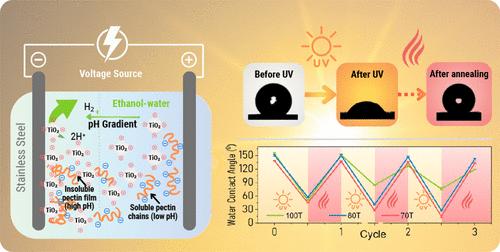电泳沉积TiO2/果胶复合涂层的光、热响应可逆润湿性和防腐性能
IF 3.9
2区 化学
Q2 CHEMISTRY, MULTIDISCIPLINARY
引用次数: 0
摘要
具有可逆润湿性的刺激响应涂层在生物医学、环境和工业应用中具有巨大的前景。其中,二氧化钛(TiO2)基涂料因其独特的光响应性和高折射率而受到广泛研究;然而,它们往往依赖复杂和资源密集的生产过程,引起了环境和经济问题。本研究介绍了一种可持续的替代方案,即通过简单的电泳沉积工艺在不锈钢上制备二氧化钛-果胶复合涂层。果胶是一种可再生的亲水性多糖,专门用于优化涂层的润湿性。在此,我们发现tio2 -果胶复合涂层表现出可逆的润湿性,在紫外线照射下从超疏水(154°)转变为亲水(57.46°),并通过80°C的热处理完全恢复。紫外照射前后的傅里叶变换红外和x射线光电子能谱证实了复合材料的化学和结构形态,果胶浓度在调节这种可逆行为中起关键作用。从机理上讲,果胶的官能团与TiO2的表面特性协同作用,增强了反应性的水吸附和可切换的润湿性。动电位极化试验显示出混合型缓蚀行为,NaCl溶液浸泡1和7天后,腐蚀电流密度分别为180和221.3 nA/cm2,在盐水条件下表现出持续的耐蚀性。这些环保的二氧化钛-果胶复合涂料提供了一种多功能的解决方案,结合了可持续的设计和可逆的润湿性和耐腐蚀性。本文章由计算机程序翻译,如有差异,请以英文原文为准。

Photo- and Thermoresponsive Reversible Wettability and Corrosion Protection of Electrophoretically Deposited TiO2/Pectin Composite Coatings
Stimuli-responsive coatings with reversible wettability hold substantial promise for biomedical, environmental, and industrial applications. Among these, titanium dioxide (TiO2)-based coatings are widely studied for their unique photoresponsivity and high refractive index; however, they often rely on complex and resource-intensive production processes, raising environmental and economic concerns. This study introduces a sustainable alternative with a TiO2-pectin composite coating on stainless steel fabricated via a simple electrophoretic deposition process. Pectin, a renewable hydrophilic polysaccharide, was incorporated specifically to optimize the coating wettability. Here, we show that TiO2-pectin composite coatings exhibit reversible wettability, transitioning from superhydrophobic (154°) to hydrophilic (57.46°) under UV irradiation, with complete recovery through thermal treatment at 80 °C. Fourier-transform infrared and X-ray photoelectron spectroscopy before and after UV exposure confirm the composites’ chemical and structural morphology, with pectin concentration playing a key role in modulating this reversible behavior. Mechanistically, pectin’s functional groups synergize with TiO2’s surface properties to enhance responsive water adsorption and enable switchable wettability. Potentiodynamic polarization tests reveal mixed-type inhibition behavior, with corrosion current densities of 180 and 221.3 nA/cm2 after 1 and 7 days of NaCl solution immersion, respectively, demonstrating sustained corrosion resistance under saline conditions. These eco-friendly TiO2-pectin composite coatings offer a multifunctional solution combining sustainable design with reversible wettability and corrosion resistance.
求助全文
通过发布文献求助,成功后即可免费获取论文全文。
去求助
来源期刊

Langmuir
化学-材料科学:综合
CiteScore
6.50
自引率
10.30%
发文量
1464
审稿时长
2.1 months
期刊介绍:
Langmuir is an interdisciplinary journal publishing articles in the following subject categories:
Colloids: surfactants and self-assembly, dispersions, emulsions, foams
Interfaces: adsorption, reactions, films, forces
Biological Interfaces: biocolloids, biomolecular and biomimetic materials
Materials: nano- and mesostructured materials, polymers, gels, liquid crystals
Electrochemistry: interfacial charge transfer, charge transport, electrocatalysis, electrokinetic phenomena, bioelectrochemistry
Devices and Applications: sensors, fluidics, patterning, catalysis, photonic crystals
However, when high-impact, original work is submitted that does not fit within the above categories, decisions to accept or decline such papers will be based on one criteria: What Would Irving Do?
Langmuir ranks #2 in citations out of 136 journals in the category of Physical Chemistry with 113,157 total citations. The journal received an Impact Factor of 4.384*.
This journal is also indexed in the categories of Materials Science (ranked #1) and Multidisciplinary Chemistry (ranked #5).
 求助内容:
求助内容: 应助结果提醒方式:
应助结果提醒方式:


